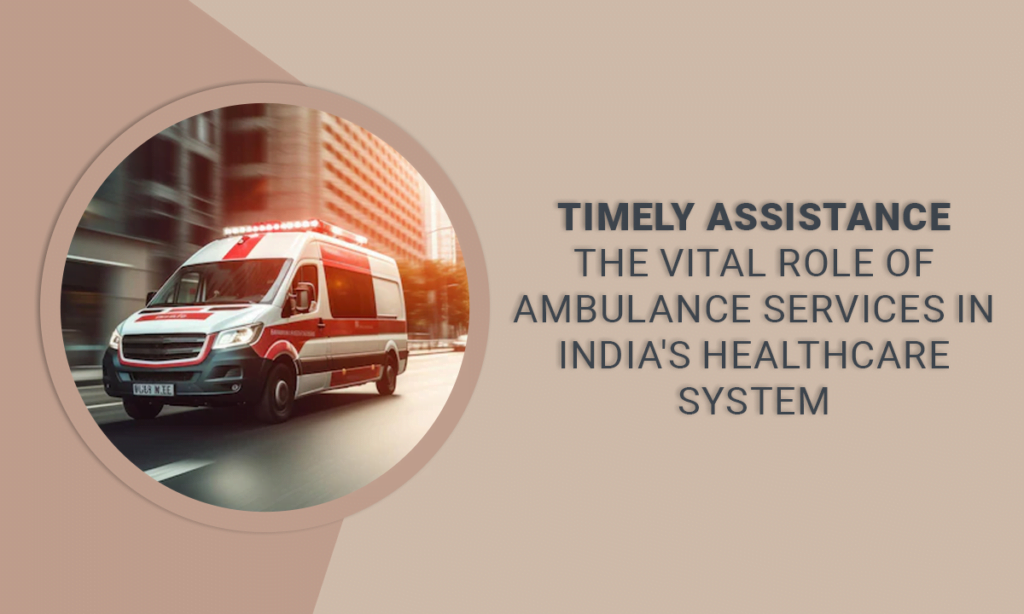In the vast and varied landscape of India’s healthcare system, ambulance services operate as critical lifelines, connecting patients with the immediate care they need. The golden hour, or the first hour after a traumatic injury, is often the most crucial period that determines the patient’s survival and long-term prognosis. Ambulance services in India are not just about transportation; they are about providing timely medical intervention during emergencies.
This blog post delves into the indispensable role of ambulance services in India, highlighting their importance, challenges, and the road ahead.
The Pulse of Emergency Care: Importance of Ambulance Services
Ambulance services are often the first point of contact between a patient and medical care. In a country where healthcare disparities are pronounced, these services are the bridge that spans the gap between remote areas and urban medical centers.
Saving Lives in the Golden Hour
The concept of the golden hour underlines the urgency of reaching medical care post-injury or onset of illness. Ambulance services equipped with advanced life support systems play a pivotal role in ensuring that patients receive care within this critical window.
Beyond Transportation: Pre-Hospital Care
Modern ambulance services in India are evolving from mere transport vehicles to mobile units capable of providing pre-hospital care. This includes administering first aid, performing CPR, and stabilizing patients en route to the hospital.
Accessibility and Reach
With the advent of centralized emergency numbers and government initiatives like ‘108’ services, access to ambulance services has improved, ensuring that even those in remote areas can summon help in times of need.
Navigating Challenges: The Roadblocks in Service Delivery
Despite their critical role, ambulance services in India face a myriad of challenges that hinder their efficiency and effectiveness.
Infrastructure and Traffic Woes
Poor road conditions and congested traffic in cities can significantly delay ambulances, reducing the chances of timely medical intervention. The lack of dedicated lanes for emergency vehicles is a pressing issue that needs to be addressed.
Diverse Terrains and Rural Reach
India’s diverse topography presents unique challenges in reaching patients in rural and hilly areas. The need for ambulances that can navigate these terrains is crucial to ensure no one is left without aid.
Training and Equipment
The variability in the quality of training for ambulance personnel and the availability of essential life-saving equipment can compromise the level of care provided during transportation.
Awareness and Education
A significant portion of the population is unaware of the proper use of ambulance services, often leading to delays in calling for help or misuse of the services for non-emergency transportation.
Innovations in Ambulance Services: Adapting to New Needs
In response to the challenges, there have been several innovations and improvements in the field of ambulance services in India.
Tech-Driven Dispatch and Tracking
The integration of GPS and mobile technology has improved the dispatch and tracking of ambulances, enabling them to reach patients more quickly and efficiently.
Specialized Ambulance Services
The introduction of specialized ambulances, such as neonatal, bariatric, and air ambulances, has catered to the specific needs of different patient groups, ensuring tailored care during transportation.
Community Participation
Community-based models, where locals are trained in basic life support and equipped with two-wheeler ambulances, have shown promise in providing swift assistance, especially in rural areas.
Public-Private Partnerships
Collaborations between the government and private entities have led to an increase in the number of ambulances and improvements in service quality, with private players bringing in expertise and resources.
The Human Factor: Training and Sensitization
The success of ambulance services is heavily dependent on the individuals who operate them. Investing in the human factor is essential for improving the overall quality of emergency medical services.
Professional Training
Providing comprehensive training to ambulance staff, including drivers, paramedics, and emergency medical technicians, ensures that they are well-equipped to handle medical emergencies.
Sensitization Programs
Sensitization programs for the public, including how and when to call for an ambulance, can lead to more efficient utilization of these services.
Stress Management
Working in emergency services can be highly stressful. Regular workshops and counseling for ambulance staff can help them manage stress and prevent burnout.
Conclusion: The Road Ahead for Ambulance Services in India
The role of ambulance services in India’s healthcare system is undeniably vital. As the nation continues to grapple with the challenges posed by a growing population and an overburdened healthcare infrastructure, the need for efficient and effective ambulance services has never been greater. The road ahead involves not only upgrading the existing services but also innovating and adapting to the changing healthcare landscape.
It is a road that requires the collective effort of the government, healthcare providers, and the community. With continued focus and investment, ambulance services can be transformed to meet the needs of all Indians, ensuring that timely medical assistance is not a matter of chance but a guaranteed provision for every citizen.
As we envision the future of healthcare in India, ambulance services stand out as a beacon of hope and a reminder that every second counts. By strengthening these services, we reinforce the very foundation of emergency care, ultimately saving lives and improving health outcomes across the nation. Let’s commit to supporting and enhancing these vital services, for they are not just vehicles on the road; they are carriers of hope, agents of survival, and the very embodiment of timely assistance.
People Also Read: Saving Lives One Pint at a Time: The Importance of Blood Donation Camps in India
